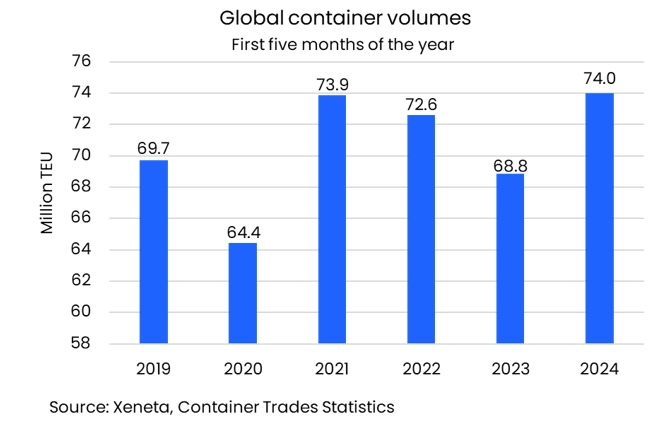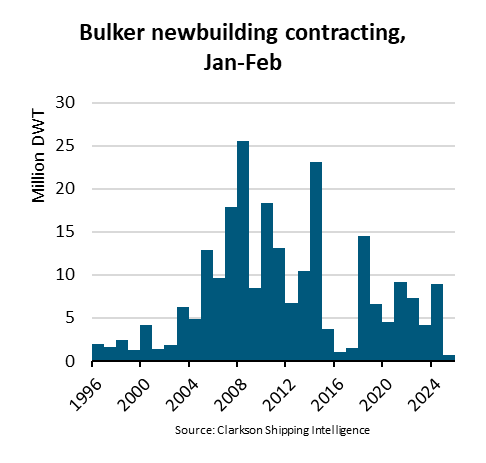Global demand for ocean freight container shipping hit an all-time record in May amid soaring spot rates and severe port congestion.
The 15.94m TEU (20-foot equivalent container) transported by ocean in May beats the previous record of 15.72 TEU set in May 2021, according to data released by Xeneta and Container Trades Statistics.
The record levels of demand in May brings year-to-date volumes to just under 74m TEU, which is an increase of 7.5% compared to the first five months of 2023.
Emily Stausbøll, Xeneta Senior Shipping Analyst, said: “More containerized goods are being shipped by ocean than ever before at a time when available capacity is impacted by diversions around Africa due to conflict in the Red Sea and severe port congestion in Asia and Europe.
“This is a perfect storm of pressure on ocean supply chains which has resulted in the chaos of recent months. In many respects it is impressive that global shipping networks have been able to transport this enormous volume of containers under such challenging circumstances.”
The record-breaking level of global demand is largely driven by volumes out of the Far East, with China seeing an all-time-high 6.2m TEU exported in May (including 853 000 TEU of intra-China container demand). This accounts for 39% of global container trade in May and coincided with spiraling spot rates on major fronthaul trades.
The latest data from Xeneta – the leading ocean and air freight rate benchmarking and intelligence platform – shows average spot rates from the Far East to US West Coast stood at USD 7840 per FEU on 9 July, up by 200% since 30 April.
Into the US East Coast, average spot rates have increased by 130% in the same period to stand at USD 9550 per FEU. Into North Europe and the Mediterranean, spot rates have increased by 148% and 88% respectively to stand at USD 8030 and USD 7830 per FEU.
Stausbøll said: “Given we are already seeing record-breaking volumes in May ahead of the traditional peak season in Q3, you can understand why shippers are so concerned.
“The spot market is still climbing, the conflict in the Red Sea shows no signs of ending and the port congestion we are seeing in Asia and Europe will take time to de-pressurise.
“The big question for the market is whether the record volumes in May will mean reduced volumes in the traditional peak season. Numerous factors come into play, not only underlying consumer demand, but also nervous shippers frontloading imports and the potential for further tariffs on China imports.
“While this combination could keep demand high moving through the next few months, there must be a limit to how long the record-levels of demand can last.”
The impact of the record levels of demand combined with longer sailing distances around the Cape of Good Hope is demonstrated through TEU-mile calculations. This data reflects the distance each container is transported globally.
TEU-miles have increased by 17.9% globally in 2024 to date compared to the same period in 2023. This is mostly driven by the Red Sea diversions and longer sailing distances around the Cape of Good Hope.
However, the trades most impacted by the Red Sea diversions are the major deep sea trades out of the Far East, which are also the trades which are driving the record-breaking levels of ocean container shipping demand.
Had ocean container carriers continued to utilize the Suez Canal, TEU-miles would have increased by a lesser, but still significant, 8.6% in 2024 to-date.
Stausbøll said: “Earlier this year we saw increasing ocean freight shipping spot rates and wondered if there really was a capacity crunch or whether it was a case of the market panicking unnecessarily following the escalation of conflict in the Red Sea.
“We can now clearly see in the data the squeeze on capacity was very real, especially when you factor in the TEU-mile increase on top of the record-breaking global volumes and port congestion.
“It also demonstrates how much oversupply of capacity there would have been in the market in 2024 had the Red Sea conflict not occurred.”
source: Xeneta
The opinions expressed herein are the author's and not necessarily those of The Xinde Marine News.
Please Contact Us at:
media@xindemarine.com


 Ningbo Containerized Freight Index Weekly Commentar
Ningbo Containerized Freight Index Weekly Commentar  Ningbo Containerized Freight Index Weekly Commentar
Ningbo Containerized Freight Index Weekly Commentar  Ningbo Containerized Freight Index Weekly Commentar
Ningbo Containerized Freight Index Weekly Commentar  BIMCO Shipping Number of the Week: Bulker newbuildi
BIMCO Shipping Number of the Week: Bulker newbuildi  Ningbo Containerized Freight Index Weekly Commentar
Ningbo Containerized Freight Index Weekly Commentar  Ningbo Containerized Freight Index Weekly Commentar
Ningbo Containerized Freight Index Weekly Commentar